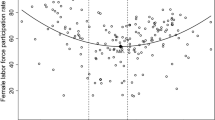Abstract
Current processes linking different parts of the world together economically and culturally are referred to asglobalisation. Though this term has gained immense popularity within a short time, critics have argued that it is hard to find empirical evidence that the world is becoming ‘one’. A crucial question is thenhow to look for such evidence. In many studies of globalisation, the general view taken is that of ‘global’, meaning that one searches for a global overview, or outlook, which is situated at no specific place. The present paper argues for a shift of focus, reasoning that to understand what is global we have to start with the local. The experiences of the global take place in particular local places, and to study such processes of change we need to situate our study in such a way that we can study the relationships between the local and the global. The particular place where our study takes place is rural Malaysia. Changes related to industrialisation are often spoken of in rather deterministic terms, in the sense that the local population are ‘victims’ of a global shift, whereas we argue for an alternative approach, analysing women workers as agents of change within their local community. Globalisation also mainly refers to external forces imposed on local actors, whereas we find the local to be imperative for the strategies of industrialists, as well as for the present processes of change.
Similar content being viewed by others
References
Daud, F. (1985). Minah Karan: The Truth about Malaysian Factory Girls. Berita, Kuala Lumpur.
Featherstone, M. (Ed.) (1990). Global culture: Nationalism, Globalization and Modernity. Sage, London.
Firth, R. (1966). Housekeping Among Malay Peasants. Athlone, London.
Frobel, F., Heinrichs, J. and Kreye, O. (1980). The New International Division of Labour. Cambridge University Press, Cambridge, UK.
Ghai, D. (1997). Economic Globalization, Institutional Change and Human Security. Discussion Paper, United Nations Research Institute for Social Development.
Giddens, A. (1990). The Consequences of Modernity. Polity Press, Cambridge, UK.
Haraway, D. (1991). Simians, Cyborgs, and Women: The Reinvention of Nature. Free Association Books, London.
Heyzer, N., Anwar, Z. and Zain, K. (1989). Islamic Revivalism and Women in Malaysia: A Case Study. Asian Pacific Development Centre, Kuala Lumpur.
Hirst, P. and Thompson, G. (1996). Globalization in Question: The International Economy and the Possibilities of Governance. Polity Press, Cambridge, UK.
Kearney, M. (1995). The Local and the Gobal: The Anthropology of the Globalization and Transnationalism, Annual Review of Anthropology. 24, 547–565
Lie, M. (1999). Two Generations: Life Stories and Social Change in Malaysia, Journal of Gender Studies. Forthcoming.
Lie, M. and Lund, R. (1991). What Is She up To? Changing Identities and Values Among Women Workers in Malaysia. In Stolen, K.A. and Vaa, M. (eds)Gender and Change in Developing Countries. Norwegian University Press, Oslo.
Lie, M. and Lund, R. (1994). Renegotiating Local Values. NIAS, Copenhagen/Curzon, London.
Lim, L.Y.C. (1983). Are Multinationals the Problem? No, Multinational Monitor. August. 14–16
Lim, L.Y.C. (1985). Women Workers in Multinational Enterprises in Developing Countries. ILO, Geneva.
Lund, R. (1994). Gender and Place: Towards a Geography Sensitive to Gender, Place and Social Change. Department of Geography, University of Trondheim.
Lund, R. and Lie, M. (1989). The Role of Women in the New International Division of Labour: The Case of Malaysian Women in Norwegian Industry,Norwegian Journal of Geography.43, 95–04.
Massard, J. (1998). The Sharing of Children in Malay Society,Jurnal Antropologi dan sosiologi.16, 63–76
Massey, D. and Jess, J. (1995). Place and Placelessness. Open University Press, Buckingham, UK.
Nash, J. and Fernandez-Kelly, (1983). Women, Men and the International Division of Labour. State University of New York Press, Albany, NY.
O'Connor, D. and Wong, C.S. (1983). Are Multinationals the Problem? Yes, Multinational Monitor. August. 15
Ong, A. (1987). Spirits of Resistance and Capitalist Discipline: Factory Women in Malaysia. State University of New York Press, Albany, NY.
Robertson, R. (1992). Globalization: Social Theory and Global Culture. Sage, London.
Rudie, I. (1994). Visible Women in East Coast Malay Society. Scandinavian University Press, Oslo.
Strange, H. (1981). Rural Malay Women in Tradition and Transition. Praeger, New York.
Vilby, K. (1997). Den globale reisen. Scandinavian University Press, Oslo.
Waters, M. (1995). Globalization. Routledge, London.
Women and Geography Group (1997). Feminist Geographies: Exploration in Diversity and Difference. Longman, London.
Author information
Authors and Affiliations
Corresponding author
Rights and permissions
About this article
Cite this article
Lie, M., Lund, R. Globalisation, place and gender. AI & Soc 13, 107–123 (1999). https://doi.org/10.1007/BF01205261
Issue Date:
DOI: https://doi.org/10.1007/BF01205261




